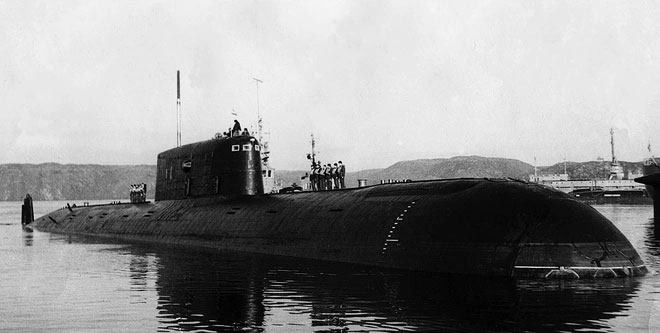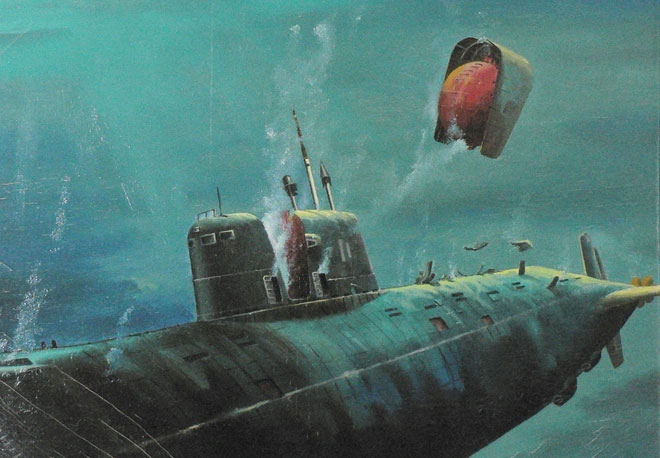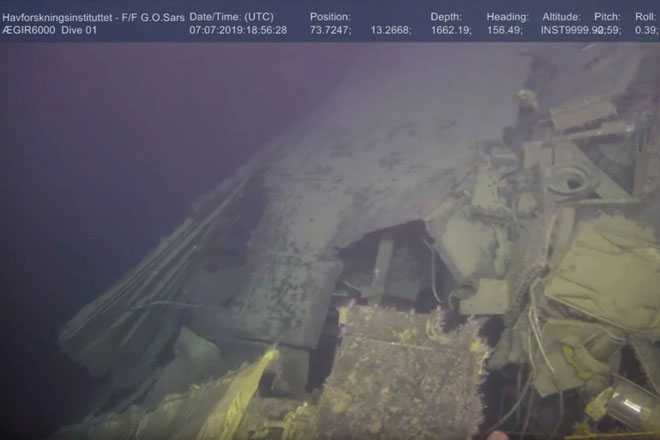The Komsomolets submarine carried the hopes of the Soviet Union to break every record, but this ambition ultimately led it beyond acceptable limits, resulting in tragedy.
For a long time, depths below 600 meters in the ocean were primarily destinations for research submarines studying marine life and some smaller technical vessels.
However, during the Cold War, with aspirations to create the world’s deepest military submarine, the Soviet Union launched the K-278 Komsomolets submarine, capable of reaching depths of 1,000 meters.
The Deepest Titan Submarine in the World

The design phase of the submarine began in 1966 and was completed in 1974.
The K-278 Komsomolets is the only military submarine of Russia that belongs to the Project 685 Plavnik, also known as “Mike” according to NATO reports.
Project 685 was created by the Rubin Design Bureau to meet the demand for a modern submarine capable of carrying 6 torpedoes and guided missiles with conventional or nuclear warheads.
The design phase of the submarine began in 1966 and was completed in 1974. The submarine was built at the Sevmash plant in Severodvinsk, launched in 1983, and commissioned into the Russian Navy in late December of the same year.
In terms of size, the Komsomolets measures 117.5 meters in length, 9 meters in width, displacing between 4,400 to 5,750 tons when surfaced and 6,400 to 8,000 tons when submerged.

The submarine is equipped with 1 OK-650 b-3 reactor with a power output of 190 MW.
Inside the submarine, there are 7 reinforced compartments, with the 2nd and 3rd compartments protected by front and rear bulkheads, creating a safer area in case of emergencies, and even allowing the crew to escape through an escape pod located in the sail.
The submarine is equipped with 1 OK-650 b-3 reactor with a power output of 190 MW, 2 steam turbines generating 45,000 horsepower, along with many modern technologies, enabling it to dive deeper than 1 kilometer, surpassing all submarines of its time.
True to its design goals, the K-278 Komsomolets has 6 torpedo tubes of 533 mm, capable of launching Type 53-65 torpedoes, VA-111 Shkval torpedoes, and SS-N-15 Starfish anti-submarine missiles. Although the K-278 was initially built for technology testing, it was eventually armed and combat-ready by 1988.
With its lightweight and durable characteristics, titanium offers many advantages for submarines compared to standard steel structures, most notably in speed, as it can travel at 14 knots (26 km/h) on the surface and 26 to 30 knots (48 – 56 km/h) when submerged.
Moreover, this metal is also resistant to corrosion and is non-magnetic, making the submarine harder to detect by magnetic anomaly detectors (MAD) used on naval ships.
The Komsomolets was seen as a breakthrough, being nearly “invulnerable” at a depth of 1,000 meters, as most torpedoes, such as the American Mark 48, have a maximum operational depth of only 800 meters.
Tragedy Claims 42 Sailors
On April 7, 1989, while operating at a depth of 386 meters, the Komsomolets encountered a disaster in the Norwegian Sea.
According to recorded documents, a fire broke out in the 7th compartment, located near the stern of the submarine.
The cause of the incident is believed to be a technical failure. Coincidentally, the crew on board was the second group recently trained to operate the submarine. Furthermore, due to the submarine’s experimental nature, it lacked some components to control malfunctions.
The fire damaged the air supply valves, causing all firefighting efforts to fail. As a result, the reactor on board was shut down, but the buoyancy system was activated to bring the submarine to the surface.

An image showing the escape capsule of the K-278 Komsomolets submarine used when necessary. (Photo: Hisutton)
At that time, Captain Evgeny Vanin sent a distress signal to the Soviet Navy, but due to the incomplete signal, those on shore were unaware of the submarine’s dangerous situation.
Meanwhile, the fire was so intense that the rubber soundproofing on the outer hull peeled off due to the heat.
After several hours battling the flames, the Komsomolets surfaced. The sailors joyfully climbed onto the deck, waiting for rescue aircraft to arrive. However, due to the near-freezing water temperature in the Norwegian Sea (~ 2 degrees Celsius), most of the sailors died from hypothermia.
At that time, Captain Vanin and 4 other sailors were returning inside the Komsomolets to search for other survivors. However, the fierce fire prevented Vanin and the rescue teams from going any deeper.
As they were attempting to exit, the submarine unexpectedly nosedived and sank to the ocean floor. Those inside the submarine did not have time to escape and perished.
After about an hour, rescue boats arrived and saved a total of 30 people. However, among those rescued, a few later died on the way to the hospital. Thus, out of the original 69 sailors aboard the submarine at the time of the disaster, 42 died, including Captain Vanin.
Radiation Still Leaks to This Day

The wreck of the submarine lies at a depth of 1,600 meters. (Photo: Hisutton)
The fate of the Komsomolets submarine—a “monster” once considered a pride of the Soviet Union—is not much better, as it sank to a depth of 1,600 meters along with its nuclear reactor and 2 Shkval torpedoes armed with nuclear warheads.
From 1989 to 1998, Russia conducted 7 missions to assess the condition of the submarine and concluded that it was severely damaged, but the torpedoes and nuclear reactor on board did not pose a significant threat to the environment. Nevertheless, a nuclear disaster could occur if the hull were to corrode.
As of 2009, Russian authorities had surveyed and inspected the Komsomolets over 70 times to prevent radiation leaks and seal the torpedo tubes. They also repeatedly planned to salvage the Komsomolets, but to no avail.
Ultimately, Russia had to abandon this intention when surveys showed that salvaging the submarine carried too great a risk of a nuclear disaster.
They were forced to use special measures to encase the submarine, turning it into a colossal “titanium tomb” resting at a depth of 1,600 meters on the ocean floor of Norway, alongside the crew members who perished in the tragedy.


















































